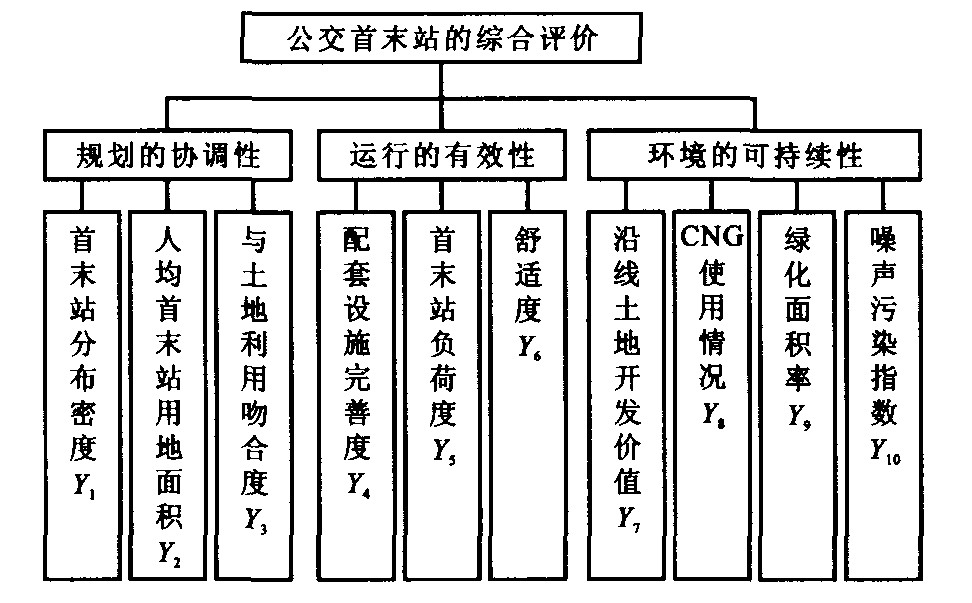Comprehensive evaluation on original and terminal stations of urban public transport
-
摘要: 为评价城市公交首末站的布局优劣、运营状况、服务水平, 进而优化规划方案, 遵循综合性、实用性、可比性、独立性和相容性的原则, 从规划的协调性、运行的有效性、环境的可持续性三个方面, 运用层次分析法, 建立了综合评价体系, 提出了10项评价指标。结合工程实际, 以定量与定性相结合的方法给出了指标的定义、计算方法和指标分级值; 提出了基于系统聚类分析法的综合评价方法。应用结果表明, 该评价体系能够全面评价公交首末站的布局、运营状况及社会环境, 具有广泛的适用性和良好的可操作性, 可以用于公交首末站的规划与管理。Abstract: In order to evaluate the layout, operation and service level of urban public transport original and terminal stations, and to optimize planning schemes, according to the five principles, such as comprehensiveness, practicability, comparability, independency and compatibility, ten evaluation indices were given respectively based on planning harmony, operational efficiency and environmental sustainability. The comprehensive evaluation system was conceived with AHP theory. In practical engineering, the indices were defined, their calculating methods and grade values were presented, the comprehensive evaluation method based on systemic clustering analysis theory was brought forward. The applied results indicate that this evaluation system could reflect comprehensively the layout, operation and environment impact of public transport original and terminal stations, and has extensive applicability and good operability, and could be used to plan and manage the original and terminal stations system of urban public transport.
-
表 1 密度指标分布
Table 1. Density grade distribution
级别 好 较好 一般 较差 差 范围/(个·km-2) 0.6~0.8 0.8~1.0或0.5~0.6 1.0~1.2或0.4~0.5 1.2~1.4或0.3~0.4 1.4~1.6或0.2~0.3 指数 1.00~0.81 0.80~0.61 0.60~0.41 0.40~0.21 0.20~0 表 2 用地面积指标
Table 2. Area index
级别 好 较好 一般 较差 差 范围/(m2·人-1) 0.17~0.20 0.14~0.17 0.11~0.14 0.08~0.11 0.05~0.08 指数 1.00~0.81 0.80~0.61 0.60~0.41 0.40~0.21 0.20~0 表 3 吻合程度指标
Table 3. Anastomose degree index
级别 好 较好 一般 较差 差 范围 U21 U2(U21) U(U2、U21) U以外 指数 1.00~0.81 0.80~0.61 0.60~0.41 0.40~0.21 0.20~0 表 4 配套设施完善度指标
Table 4. Perfectness grade index of facilities
首末站提供配套设施的比例/% 0~30 30~50 50~70 70~90 > 90 调度室设施状况值/k1 0~0.29 0.30~0.49 0.50~0.69 0.70~0.89 0.90~1.00 后勤保障设施状况值/k2 0~0.39 0.40~0.69 0.70~0.84 0.85~0.94 0.95~1.00 出入口设施状况值/k3 0~0.29 0.30~0.49 0.50~0.79 0.80~0.94 0.95~1.00 调停区设施状况值/k4 0~0.39 0.40~0.69 0.70~0.89 0.90~1.00 1.00 表 5 负荷度指标
Table 5. Load grade index
级别 好 较好 一般 较差 差 范围 0.79~0.65 0.80~0.85或0.64~0.50 0.86~0.90或0.49~0.35 0.91~0.96或0.34~0.20 > 0.96或0.19~0 指数 1.00~0.81 0.80~0.61 0.60~0.41 0.40~0.21 0.20~0 表 6 服务水平
Table 6. Service level
服务水平 条件 指标值 一级 客流密度低, 车辆在场内到发运行流畅, 乘客上下车顺畅, 设施能力极度富余 0~0.44 二级 客流密度较低, 车辆在场内到发运行较流畅, 乘客上下车便捷, 设施能力有较大的富余 0.45~0.64 三级 客流密度适中, 车辆在场内到发运行以及乘客上下车受到较小的干扰和限制(三级服务水平一般作为首末站设计标准) 0.65~0.79 四级 客流密度较大, 车辆在场内到发运行受到较大的干扰和限制, 乘客上下车舒适性差, 存在不安全因素 0.80~0.89 五级 客流密度大, 接近或达到设计容量, 车辆在场内到发运行极不顺畅, 乘客乘车条件差, 不安全因素多 0.90~1.00 表 7 舒适度指标
Table 7. Comfort degree index
首末站提供设施的比例/% 0~30 30~50 50~70 70~90 > 90 换乘条件状况值/j1 0~0.29 0.30~0.49 0.50~0.69 0.70~0.89 0.90~1.00 候车廊设施状况值/j2 0~0.29 0.30~0.49 0.50~0.69 0.70~0.89 0.90~1.00 标志设施状况值/j3 0~0.29 0.30~0.69 0.70~0.89 0.90~1.00 1.00 表 8 土地开发价值指标
Table 8. Index of land development worth
级别 好(一级) 较好(二级) 一般(三级) 较差(四级) 差(五级及以外) 范围 — — — — — 指数 1.00~0.81 0.80~0.61 0.60~0.41 0.40~0.21 0.20~0 表 9 CNG使用情况指标
Table 9. CNG used rate index
级别 好 较好 一般 较差 差 范围/% > 90 90~70 70~50 50~30 30~0 指数 0~-0.20 -0.21~-0.40 -0.41~-0.60 -0.61~-0.80 -0.81~-1.00 表 10 绿化面积率指标
Table 10. Green area rate index
级别 好 较好 一般 较差 差 范围/% > 30 30~20 20~15 15~8 8~0 指数 1.00~0.81 0.80~0.61 0.60~0.41 0.40~0.21 0.20~0 表 11 噪声污染指数
Table 11. Noise pollution index
级别 好 较好 一般 较差 差 范围/% 0~45 46~55 56~65 66~75 > 75 指数 -1~0 -1.22~-1.10 -1.44~-1.23 -1.67~-1.45 < -1.67 表 12 权重系数
Table 12. Weight coefficients
子系统 权重值 指标名称 指标权重值 规划的协调性 0.35 首末站分布密度 0.15 人均首末站用地面积 0.10 与土地利用吻合度 0.10 运行的有效性 0.40 配套设施完善度 0.10 首末站负荷度 0.20 舒适度 0.10 环境的可持续性 0.25 沿线土地开发价值 0.10 CNG使用情况 0.05 绿化面积率 0.05 噪声污染指数 0.05 -
[1] 刘小明, 沈龙利, 杨孝宽. 城市客运枢纽综合评价指标体系研究[J]. 中国公路学报, 1995, 8(Sup1): 97-102. https://www.cnki.com.cn/Article/CJFDTOTAL-ZGGL5S1.016.htmLIU Xiao-ming, SHEN Long-li, YANG Xiao-kuan. Overall evaluation indicator of urban passenger transfer hub[J]. China Journal of Highway and Transport, 1995, 8(Sup1): 97-102. (in Chinese) https://www.cnki.com.cn/Article/CJFDTOTAL-ZGGL5S1.016.htm [2] 席庆, 霍娅敏, 叶怀珍. 交通运输枢纽中客运站点布局问题的研究[J]. 西南交通大学学报, 1999, 34(3): 374-378. https://www.cnki.com.cn/Article/CJFDTOTAL-XNJT903.023.htmXI Qing, HUO Ya-min, YE Huai-zhen. Study on the installation of passenger station in communications and transportation hub[J]. Journal of Southwest Jiaotong University, 1999, 34 (3): 374-378. (in Chinese) https://www.cnki.com.cn/Article/CJFDTOTAL-XNJT903.023.htm [3] 夏绍玮. 系统工程概论[M]. 北京: 清华大学出版社, 1995. [4] 林肇信, 刘天齐. 环境保护概论[M]. 北京: 高等教育出版社, 1999. [5] 王炜. 城市交通系统能源消耗与环境影响分析方法[M]. 北京: 科学出版社, 2002. [6] 覃煜, 晏克非, 赵童. 城市综合客运交通体系中换乘研究[J]. 长沙交通学院学报, 2000, 16(2): 67-72. https://www.cnki.com.cn/Article/CJFDTOTAL-CSJX200002014.htmQIN Yu, YAN Ke-fei, ZHAO Tong. A study on the change system of urban synthetic passenger transport system[J]. Journal of Changsha Communications University, 2000, 16(2): 67-72. (in Chinese) https://www.cnki.com.cn/Article/CJFDTOTAL-CSJX200002014.htm -





 下载:
下载:


